#cemetery Yalta
Explore tagged Tumblr posts
Video
youtube
Кошмар. Корова на кладбище Ялты. Радоница 7 Мая. Крым. Nightmare. Cow in...
#корова#кладбище#Ялта#Крым#жуть#ужас#кошмар#вера#Оадрница#русское кладбище#юмор#смешные животные#лучшее Ютуб#прикол#видео приколы#сатира#смортеть всем#м репортер#cemetery Yalta#Yalta cemetery#Crimea#cow#horror#nightmare#watch everyone#Russian cemetery#funeral business#Orthodox cemetery#power inaction#democracy
1 note
·
View note
Text
Кладбище троллейбусов в Ялте / Yalta trolleybuses cemetery
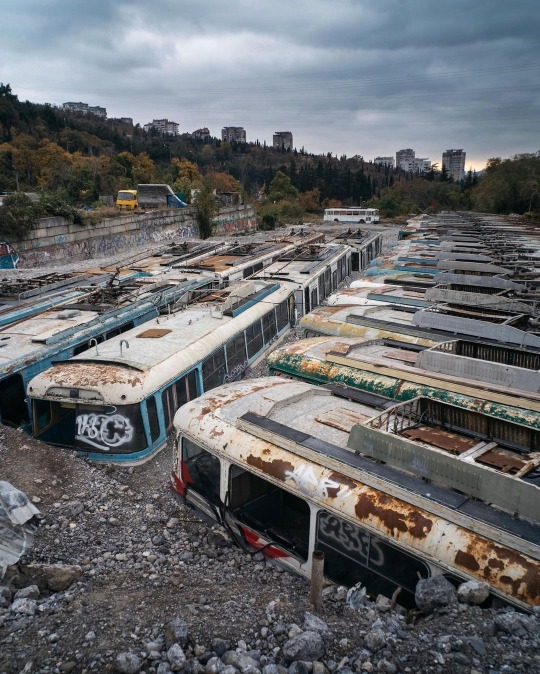
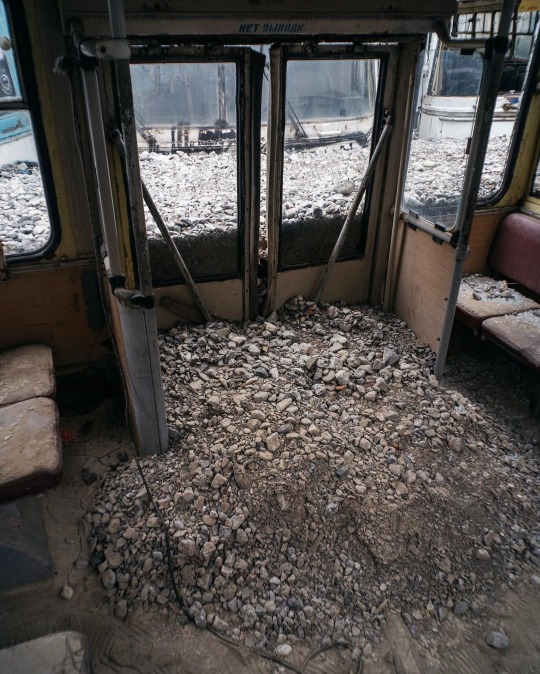
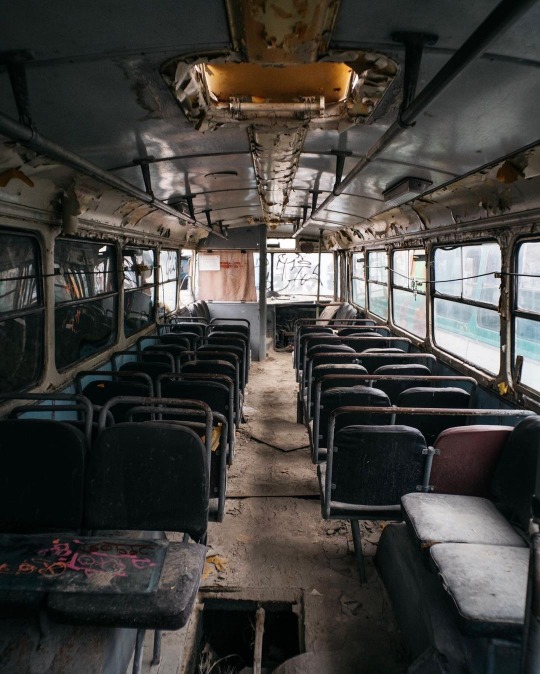


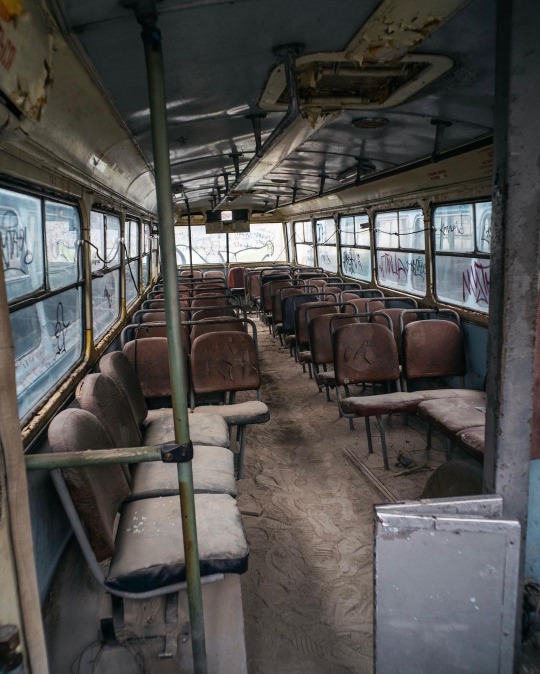
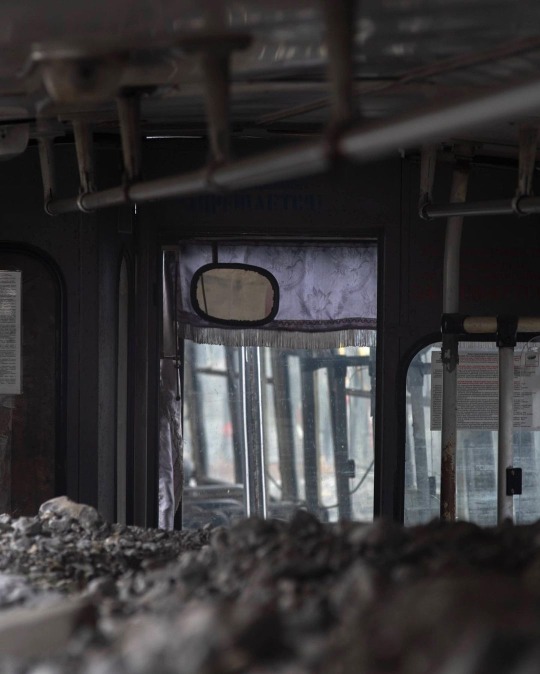

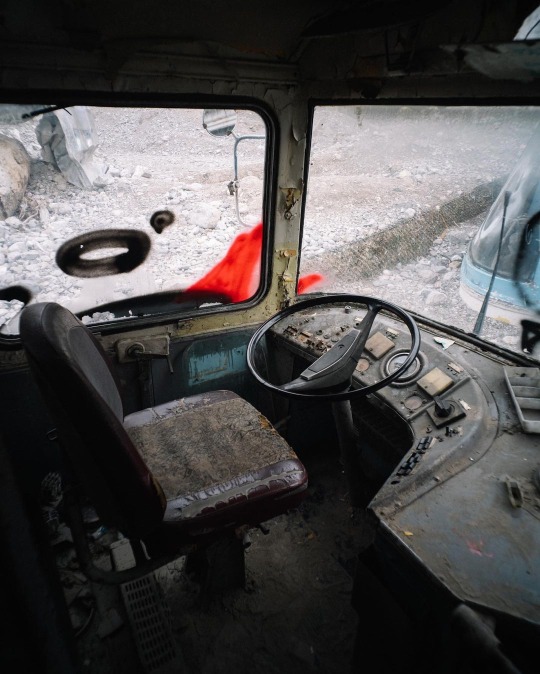

В этом парке стояли старые троллейбусы, снятые с маршрута Ялта - Симферополь, самые древние из них - Škoda 8Tr и 9Tr, закупленные СССР в 1960-х.
Летом прошлого года на Крым обрушились сильные ливни, а в Ялте сошел сель. Этот сокрушительный поток из жидкой грязи и камней двигался с гор и буквально упёрся в старые троллейбусы! Таким образом, они защитили постройки, находящиеся ниже, в том числе троллейбусный парк - иначе бы сель засыпал его территорию и мог повредить используемые машины.
На 2022 год парк расчистили от камней, и редуте троллейбусы планируют забрать в музей в Питер.
In this park there are old trolleybuses removed from the route Yalta-Simferopol, the oldest of them - Škoda 8Tr and 9Tr, purchased by the USSR in the 1960s.
Last summer, heavy rains hit the Crimea, and a mudslide came down in Yalta. This crushing torrent of liquid mud and rocks moved from the mountains and literally ran into the old trolleybuses! Thus, they protected the buildings below, including the trolleybus park - otherwise the mudflow would have covered its territory and could have damaged the cars in use.
The park was cleared of rocks for 2022, and the redoubtable trolleybuses are planned to be taken to a museum in Petersburg.
17 notes
·
View notes
Text
Today’s Poem
The Seagull --Norman Dubie
Chekhov, at Yalta
A winter evening at the cottage by the bay, And I sat in the black and gold of the dead garden Wrapped in blankets, eating my sister’s suet pudding. The fountain was wrapped in dirty straw and
Just below my property in the old Tartar cemetery There was a small funeral in progress: the widow Is wearing a purple shawl, the children are bare around The shoulders and the girls are wearing orange petals
At their throats. The ashen white beards of the men Are like immaculate vests from this distance. There is nothing more intolerable than suet pudding, Unless it is the visitors. The drunken visitors laughing
In my kitchen, eating my duck and venison, while I hide From them here in the dark garden. The daughter of one of these gentlemen is pretty. I saw her through the window drinking
Champagne from a clay mug—just under her thin blouse I saw the blue points of her breasts that turn, In opposition, both out and up like the azure slippers Of the priest who is now singing in the cemetery below my house.
Once the family has gone off with its torches I’ll Climb down to the fresh grave and drop some coins For flowers, even wooden teeth for the widow so she can
Attract a new husband? The black, turned soil Or our garden reminds me Of the common grave given to the children Of the Godunov Orphanage after that horrible fire:
A charred horse was thrown in with them, Bags of lime, and what I understood to be a large ham That the authorities, nevertheless, declared The torso of a male child of nine or ten. The Czar,
In their memory, placed a tiny trout pond over them And this inscription: A blue blanket for my little ones. My wife goes nearly naked to parties in Moscow. My sister here, at Yalta, goes sea bathing with a rope
Around her that runs back to the beach where it is Attached to a donkey who is commanded by a servant With a long switch. The sea tows her out and then the donkey is whipped
Sorrowfully until he has dragged her back to them. I named the donkey, Moon, after the mystery of his service To my sister. This winter He has been an excellent friend.
I read to this poor beast from Three Sisters. He is a better Critic and audience than I could find in the cities. I have won an Award that will save me from arrest anywhere Inside Russia. I am going to refuse it! And then travel
To Nice or Paris. My tuberculosis is worse. Tolstoi reads my stories To his family after supper. And reads them badly, I suppose! I did walk that evening all the way down to the cemetery
Only to discover that my pockets were empty. I screamed up to the house for coins, for plenty Of coins! The visitors, laughing and singing, ran down To me without coats and with a lantern swinging—
My sister trailed behind them On her donkey. Her square black hat Bobbing like a steamer way out in the bay. And when they reached me—
I said, “Sister, pack the trunks! You hurt me! I will write that we have departed for France, for Italy.”
1 note
·
View note
Text
French politicians headed by Thierry Mariani head to Crimea
Within the program, in particular, meetings are scheduled with the leadership of the State Council of the Republic of Crimea and members of the youth parliament of the peninsula.
A delegation of French politicians headed by the president of the association “Franco-Russian Dialogue” Thierry Mariani arrived in Moscow and flies to Crimea on Wednesday afternoon. Their visit will last until March 16.
As the accompanying delegation was informed by Leonid Slutsky, head of the State Duma Committee on International Affairs, it consists of honorary members of the French parliament, former and current deputies of the National Assembly, representatives of municipal authorities, including the mayors of Brien-le-Château and Biguglia. The program includes meetings with the leadership of the State Council of the Republic of Crimea and members of the youth parliament of the peninsula, visits to the French military cemetery and the cultural center “Alliance Française”.
“French politicians will be in Crimea on the eve of the fifth anniversary of the annexation of the peninsula to the Russian Federation. They will again go to the embankments of Yalta and Sevastopol, where they can meet with ordinary Crimeans and talk about their life in Russia,” said the deputy.
Slutsky recalled that Mariani had twice headed the delegation of French politicians who visited the peninsula in 2015 and 2016. “Thanks to these trips, Europe has learned the truth about the“ Crimean Spring ”and about the return of the Crimea to its native harbor,” he added. “Many of these politicians were later deprived of key powers in parliamentary structures or even lost the mandates of the deputies of the French National Assembly, but from this they did not cease to serve the truth and believe in common sense, and not to the State Department propaganda,” the Russian parliamentarian concluded.
http://interkomitet.com/main/french-politicians-headed-by-thierry-mariani-head-to-crimea/
0 notes
Text
A Meeting at the Elbe River
A Meeting at the Elbe River
By April of 1945, the War in Europe was already certainly decided. Numerous international conferences, most recently the Yalta Conference of February 1945, had confidently established a power sharing arrangement among the Allied Nations for how the defeated Germany would be divided and administered.
The Division of Germany (The black line would become the Inner German Border between West and East Germany)
All that remained was to make the unconditional defeat a reality, through the total occupation of Germany, by British and American forces from the West, and under Russian occupation from the East.
The place Eastern and Western Forces would finally been would be the village of Torgau, on the Elbe River.
Already far east of the planned border between Western and Soviet occupation zones, General Dwight Eisenhower picked the point on the Elbe River for its visibility, isolation and convenience. The Soviet Command had long demanded to have the right to occupy Berlin, and with a separate power-sharing agreement set up for the capital city, Eisenhower was quite happy to have the Soviets take on the last bastion of Germany’s most fanatical defenders.
Instead, the Army had orders to remain on the West side of the Elbe, be on the watch for Russian arrivals, and to be as friendly as possible when they arrived.
Friend or Foe?
During the Yalta Conference, a specific signal was agreed upon. At the approach of each other’s forces, American troops were supposed to fire a special green-colored signal cartridge from their rifles. The Soviets, on the other hand, were supposed to fire a red-colored signal.
But this fact had never been relayed down to the American scouts patrolling around Torgau. A solider with 273rd Regiment of the 69th Infantry, Lt. Bill Robertson spotted who he believed were the Russians. Soviet Lt. Alexander Sylvashko led that group, who has also spotted the Americans.
Per instructions, Sylvashko fired the red signal shot. But Robertson unfortunately had no similar ammunition prepared on his side. Thinking quickly, Robertson and the rest of his patrol made a crude homemade flag with a patch of blue and the familiar red and white stripes.
The initial meeting at the Elbe
Sylvashko was initially incredibly suspicious of the homemade flag. But after sending other Russians out to get a closer look and seeing them flash the “V” hand signal for victory, he finally came out to greet the Americans formally.
The bridge over the Elbe River had been severely bombed during the War. Yet across its unstable and crumbling span, American and Russian now came together and shook hands as comrades-in-arms.
A Day of Friendship
The following day, a massive celebration occurred on the river banks, in which commanders and dozens of soldiers from each side met and exchanged gifts. Buttons, stars and patches from each other’s uniforms were all common gifts.
Sylvashko and Robertson came together for one more formal photograph to commemorate the meeting.
Robertson and Sylvashko at the later Elbe Celebration
The Rise of the Iron Curtain
By May 2nd, Hitler was dead and Berlin was in Soviet hands.
The official German Surrender ending hostilities came into effect on May 7th, 1945. Americans soon followed the agreement set forth at Yalta and retreated their forces behind what would become known as the “Inner German Border”.
This Border would grow and strengthen in the coming Cold War to become the foundation of a feared Iron Curtain between competing spheres of global influence.
But in April, for just a moment, East and West were able to meet, put aside their differences, and celebrate the end to conflict, if just for a little while.
Plaques dedicated to the event exist in Moscow, Washington D.C. and Torgau, Germany. Celebrations around each plaque are held every April 25th.
This includes an official plaque at Arlington National Cemetery which bears the simple passage:
“In Recognition of the Cooperation by American, Soviet, and Allied Armed Forces During World War II. This Marker Symbolizes the Link Up of Soviet And American Elements at the Elbe River 25 April 1945.”
https://ift.tt/2JnQ2Dw
0 notes
Text
A Meeting at the Elbe River
A Meeting at the Elbe River
By April of 1945, the War in Europe was already certainly decided. Numerous international conferences, most recently the Yalta Conference of February 1945, had confidently established a power sharing arrangement among the Allied Nations for how the defeated Germany would be divided and administered.
The Division of Germany (The black line would become the Inner German Border between West and East Germany)
All that remained was to make the unconditional defeat a reality, through the total occupation of Germany, by British and American forces from the West, and under Russian occupation from the East.
The place Eastern and Western Forces would finally been would be the village of Torgau, on the Elbe River.
Already far east of the planned border between Western and Soviet occupation zones, General Dwight Eisenhower picked the point on the Elbe River for its visibility, isolation and convenience. The Soviet Command had long demanded to have the right to occupy Berlin, and with a separate power-sharing agreement set up for the capital city, Eisenhower was quite happy to have the Soviets take on the last bastion of Germany’s most fanatical defenders.
Instead, the Army had orders to remain on the West side of the Elbe, be on the watch for Russian arrivals, and to be as friendly as possible when they arrived.
Friend or Foe?
During the Yalta Conference, a specific signal was agreed upon. At the approach of each other’s forces, American troops were supposed to fire a special green-colored signal cartridge from their rifles. The Soviets, on the other hand, were supposed to fire a red-colored signal.
But this fact had never been relayed down to the American scouts patrolling around Torgau. A solider with 273rd Regiment of the 69th Infantry, Lt. Bill Robertson spotted who he believed were the Russians. Soviet Lt. Alexander Sylvashko led that group, who has also spotted the Americans.
Per instructions, Sylvashko fired the red signal shot. But Robertson unfortunately had no similar ammunition prepared on his side. Thinking quickly, Robertson and the rest of his patrol made a crude homemade flag with a patch of blue and the familiar red and white stripes.
The initial meeting at the Elbe
Sylvashko was initially incredibly suspicious of the homemade flag. But after sending other Russians out to get a closer look and seeing them flash the “V” hand signal for victory, he finally came out to greet the Americans formally.
The bridge over the Elbe River had been severely bombed during the War. Yet across its unstable and crumbling span, American and Russian now came together and shook hands as comrades-in-arms.
A Day of Friendship
The following day, a massive celebration occurred on the river banks, in which commanders and dozens of soldiers from each side met and exchanged gifts. Buttons, stars and patches from each other’s uniforms were all common gifts.
Sylvashko and Robertson came together for one more formal photograph to commemorate the meeting.
Robertson and Sylvashko at the later Elbe Celebration
The Rise of the Iron Curtain
By May 2nd, Hitler was dead and Berlin was in Soviet hands.
The official German Surrender ending hostilities came into effect on May 7th, 1945. Americans soon followed the agreement set forth at Yalta and retreated their forces behind what would become known as the “Inner German Border”.
This Border would grow and strengthen in the coming Cold War to become the foundation of a feared Iron Curtain between competing spheres of global influence.
But in April, for just a moment, East and West were able to meet, put aside their differences, and celebrate the end to conflict, if just for a little while.
Plaques dedicated to the event exist in Moscow, Washington D.C. and Torgau, Germany. Celebrations around each plaque are held every April 25th.
This includes an official plaque at Arlington National Cemetery which bears the simple passage:
“In Recognition of the Cooperation by American, Soviet, and Allied Armed Forces During World War II. This Marker Symbolizes the Link Up of Soviet And American Elements at the Elbe River 25 April 1945.”
https://ift.tt/2JnQ2Dw
0 notes
Text
A Meeting at the Elbe River
A Meeting at the Elbe River
By April of 1945, the War in Europe was already certainly decided. Numerous international conferences, most recently the Yalta Conference of February 1945, had confidently established a power sharing arrangement among the Allied Nations for how the defeated Germany would be divided and administered.
The Division of Germany (The black line would become the Inner German Border between West and East Germany)
All that remained was to make the unconditional defeat a reality, through the total occupation of Germany, by British and American forces from the West, and under Russian occupation from the East.
The place Eastern and Western Forces would finally been would be the village of Torgau, on the Elbe River.
Already far east of the planned border between Western and Soviet occupation zones, General Dwight Eisenhower picked the point on the Elbe River for its visibility, isolation and convenience. The Soviet Command had long demanded to have the right to occupy Berlin, and with a separate power-sharing agreement set up for the capital city, Eisenhower was quite happy to have the Soviets take on the last bastion of Germany’s most fanatical defenders.
Instead, the Army had orders to remain on the West side of the Elbe, be on the watch for Russian arrivals, and to be as friendly as possible when they arrived.
Friend or Foe?
During the Yalta Conference, a specific signal was agreed upon. At the approach of each other’s forces, American troops were supposed to fire a special green-colored signal cartridge from their rifles. The Soviets, on the other hand, were supposed to fire a red-colored signal.
But this fact had never been relayed down to the American scouts patrolling around Torgau. A solider with 273rd Regiment of the 69th Infantry, Lt. Bill Robertson spotted who he believed were the Russians. Soviet Lt. Alexander Sylvashko led that group, who has also spotted the Americans.
Per instructions, Sylvashko fired the red signal shot. But Robertson unfortunately had no similar ammunition prepared on his side. Thinking quickly, Robertson and the rest of his patrol made a crude homemade flag with a patch of blue and the familiar red and white stripes.
The initial meeting at the Elbe
Sylvashko was initially incredibly suspicious of the homemade flag. But after sending other Russians out to get a closer look and seeing them flash the “V” hand signal for victory, he finally came out to greet the Americans formally.
The bridge over the Elbe River had been severely bombed during the War. Yet across its unstable and crumbling span, American and Russian now came together and shook hands as comrades-in-arms.
A Day of Friendship
The following day, a massive celebration occurred on the river banks, in which commanders and dozens of soldiers from each side met and exchanged gifts. Buttons, stars and patches from each other’s uniforms were all common gifts.
Sylvashko and Robertson came together for one more formal photograph to commemorate the meeting.
Robertson and Sylvashko at the later Elbe Celebration
The Rise of the Iron Curtain
By May 2nd, Hitler was dead and Berlin was in Soviet hands.
The official German Surrender ending hostilities came into effect on May 7th, 1945. Americans soon followed the agreement set forth at Yalta and retreated their forces behind what would become known as the “Inner German Border”.
This Border would grow and strengthen in the coming Cold War to become the foundation of a feared Iron Curtain between competing spheres of global influence.
But in April, for just a moment, East and West were able to meet, put aside their differences, and celebrate the end to conflict, if just for a little while.
Plaques dedicated to the event exist in Moscow, Washington D.C. and Torgau, Germany. Celebrations around each plaque are held every April 25th.
This includes an official plaque at Arlington National Cemetery which bears the simple passage:
“In Recognition of the Cooperation by American, Soviet, and Allied Armed Forces During World War II. This Marker Symbolizes the Link Up of Soviet And American Elements at the Elbe River 25 April 1945.”
https://ift.tt/2JnQ2Dw
0 notes
Text
A Meeting at the Elbe River
A Meeting at the Elbe River
By April of 1945, the War in Europe was already certainly decided. Numerous international conferences, most recently the Yalta Conference of February 1945, had confidently established a power sharing arrangement among the Allied Nations for how the defeated Germany would be divided and administered.
The Division of Germany (The black line would become the Inner German Border between West and East Germany)
All that remained was to make the unconditional defeat a reality, through the total occupation of Germany, by British and American forces from the West, and under Russian occupation from the East.
The place Eastern and Western Forces would finally been would be the village of Torgau, on the Elbe River.
Already far east of the planned border between Western and Soviet occupation zones, General Dwight Eisenhower picked the point on the Elbe River for its visibility, isolation and convenience. The Soviet Command had long demanded to have the right to occupy Berlin, and with a separate power-sharing agreement set up for the capital city, Eisenhower was quite happy to have the Soviets take on the last bastion of Germany’s most fanatical defenders.
Instead, the Army had orders to remain on the West side of the Elbe, be on the watch for Russian arrivals, and to be as friendly as possible when they arrived.
Friend or Foe?
During the Yalta Conference, a specific signal was agreed upon. At the approach of each other’s forces, American troops were supposed to fire a special green-colored signal cartridge from their rifles. The Soviets, on the other hand, were supposed to fire a red-colored signal.
But this fact had never been relayed down to the American scouts patrolling around Torgau. A solider with 273rd Regiment of the 69th Infantry, Lt. Bill Robertson spotted who he believed were the Russians. Soviet Lt. Alexander Sylvashko led that group, who has also spotted the Americans.
Per instructions, Sylvashko fired the red signal shot. But Robertson unfortunately had no similar ammunition prepared on his side. Thinking quickly, Robertson and the rest of his patrol made a crude homemade flag with a patch of blue and the familiar red and white stripes.
The initial meeting at the Elbe
Sylvashko was initially incredibly suspicious of the homemade flag. But after sending other Russians out to get a closer look and seeing them flash the “V” hand signal for victory, he finally came out to greet the Americans formally.
The bridge over the Elbe River had been severely bombed during the War. Yet across its unstable and crumbling span, American and Russian now came together and shook hands as comrades-in-arms.
A Day of Friendship
The following day, a massive celebration occurred on the river banks, in which commanders and dozens of soldiers from each side met and exchanged gifts. Buttons, stars and patches from each other’s uniforms were all common gifts.
Sylvashko and Robertson came together for one more formal photograph to commemorate the meeting.
Robertson and Sylvashko at the later Elbe Celebration
The Rise of the Iron Curtain
By May 2nd, Hitler was dead and Berlin was in Soviet hands.
The official German Surrender ending hostilities came into effect on May 7th, 1945. Americans soon followed the agreement set forth at Yalta and retreated their forces behind what would become known as the “Inner German Border”.
This Border would grow and strengthen in the coming Cold War to become the foundation of a feared Iron Curtain between competing spheres of global influence.
But in April, for just a moment, East and West were able to meet, put aside their differences, and celebrate the end to conflict, if just for a little while.
Plaques dedicated to the event exist in Moscow, Washington D.C. and Torgau, Germany. Celebrations around each plaque are held every April 25th.
This includes an official plaque at Arlington National Cemetery which bears the simple passage:
“In Recognition of the Cooperation by American, Soviet, and Allied Armed Forces During World War II. This Marker Symbolizes the Link Up of Soviet And American Elements at the Elbe River 25 April 1945.”
https://ift.tt/2JnQ2Dw
0 notes
Video
youtube
🍎ЯЛТА ПОЛИКУРОВСКОЕ (Иоанно-Златоустовское) МЕМОРИАЛЬНОЕ КЛАДБИЩЕ🍎ПОЛИКУ...
#Поликуровский холм#поликуровское кладбище#кладбище#погост#ялтинское кладбище#Ялта#Крым#вид#пейзаж#кипар��сы#побережье Ялты#cemetery#memorial#Yalta#Yalta cemetery#celebrities#Yalta celebrities#В.С. Калинников#Эшлиман#Ф.А. Васильев#M.A. Bogdanovich#М.А. Богданович#Л.П. Радин#Н.А. Арендт#Н.Н. Амани#Е.М. Григорук#С.А. Найденов
0 notes
Video
youtube
Старинное Вознесенское Кореизское кладбище Некрополь Токмаковых, могила ...
#ancient cemetery#Koreis cemetery#the history of Koreiz#Bulgakov’s grave#Tokmakov’s grave#necropolis#Mayer’s chapel#ancient monuments#Crimea#Yalta#history of the Crimea#Romanovs#Ромаговы#Токмаков#Булгаков#Vorontsovs#Голицин#кладбище#некрополь#Крым#Кореиз#Ялта#памятники#надгробия#могилы#могила Булгакова#могила Токмакова#могила Деспот#Кореизское кладбище#старинное кладбище
0 notes
Text
Today’s Poem
The Seagull --Norman Dubie
Chekhov, at Yalta
A winter evening at the cottage by the bay, And I sat in the black and gold of the dead garden Wrapped in blankets, eating my sister’s suet pudding. The fountain was wrapped in dirty straw and
Just below my property in the old Tartar cemetery There was a small funeral in progress: the widow Is wearing a purple shawl, the children are bare around The shoulders and the girls are wearing orange petals
At their throats. The ashen white beards of the men Are like immaculate vests from this distance. There is nothing more intolerable than suet pudding, Unless it is the visitors. The drunken visitors laughing
In my kitchen, eating my duck and venison, while I hide From them here in the dark garden. The daughter of one of these gentlemen is pretty. I saw her through the window drinking
Champagne from a clay mug—just under her thin blouse I saw the blue points of her breasts that turn, In opposition, both out and up like the azure slippers Of the priest who is now singing in the cemetery below my house.
Once the family has gone off with its torches I’ll Climb down to the fresh grave and drop some coins For flowers, even wooden teeth for the widow so she can
Attract a new husband? The black, turned soil Or our garden reminds me Of the common grave given to the children Of the Godunov Orphanage after that horrible fire:
A charred horse was thrown in with them, Bags of lime, and what I understood to be a large ham That the authorities, nevertheless, declared The torso of a male child of nine or ten. The Czar,
In their memory, placed a tiny trout pond over them And this inscription: A blue blanket for my little ones. My wife goes nearly naked to parties in Moscow. My sister here, at Yalta, goes sea bathing with a rope
Around her that runs back to the beach where it is Attached to a donkey who is commanded by a servant With a long switch. The sea tows her out and then the donkey is whipped
Sorrowfully until he has dragged her back to them. I named the donkey, Moon, after the mystery of his service To my sister. This winter He has been an excellent friend.
I read to this poor beast from Three Sisters. He is a better Critic and audience than I could find in the cities. I have won an Award that will save me from arrest anywhere Inside Russia. I am going to refuse it! And then travel
To Nice or Paris. My tuberculosis is worse. Tolstoi reads my stories To his family after supper. And reads them badly, I suppose! I did walk that evening all the way down to the cemetery
Only to discover that my pockets were empty. I screamed up to the house for coins, for plenty Of coins! The visitors, laughing and singing, ran down To me without coats and with a lantern swinging—
My sister trailed behind them On her donkey. Her square black hat Bobbing like a steamer way out in the bay. And when they reached me—
I said, “Sister, pack the trunks! You hurt me! I will write that we have departed for France, for Italy.”
0 notes